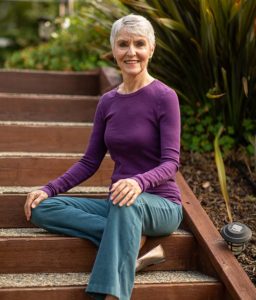Take a Look, What Do You See?
Give the following a try — ask people to describe what they see in the image above.
Most people will say something like, “a middle-aged heterosexual couple dressed in outdoorsy clothing standing face to face by the ocean.”
That’s okay, as far as it goes. But if you’ve been educated in Balance, what stands out is how far they are from the gravitational line.
These two people are not Balanced. Their pelvises push forward, their legs slant, and their torsos lean back with pronounced curves throughout their spines. Simply put, they are not vertical but rather stand in a zigzag.

Look Again
Here’s one way to remove the cultural blinkers: turn the photo upside down. Now you notice the people less, and instead what poppes out is the dramatic negative shape that separates their bodies.
Suddenly it’s obvious that these two people do not stand vertically. Instead their legs and pelvis slant forward and their torsos lean backward.
The Postural Blind Spot
Because almost everyone in our culture stands with the pelvis forward we can’t see that almost all of us lean backward. We unconsciously assume that we are vertical and everyone else is too. We all are immersed in this cultural blind spot.
What You Don’t Know Won’t Hurt You?
Not so in this case.
There are physical consequences to being out of Balance. When you live leaning backwards, every joint in your body is suffers. Misalignments causes friction in the joints and in turn creates the “wear and tear” that erodes smooth functioning. At all ages, people experience degeneration in their spine and joints and are flummoxed that there doesn’t seem to be a permanent fix. Just when one thing improves a problem arises elsewhere.
The blind spot is so pervasive that everyone is susceptible to these chronic misalignments. That includes physical therapists, doctors, coaches, PE teachers, and professors of anatomy and physiology. There are exceptions of course, often great athletes like Carl Lewis, Olympian sprinter from 1979 -1996.
People on the Axis
There are three groups of people who are on the axis — three groups we imitate and learn from. They are:
our ancestors, as shown in these Greek sculptures,

young children,

and people around the world who live vertically, on the axis.

The Good News
You can recover the Balanced posture you had as a child. Thanks to the relentless research of Noelle Perez from the Institut D”Aplomb in Paris there are specific guidelines you can learn and practice that will totally reshape your body and relieve your suffering. When you learn to be vertical, on the axis, everything you do physically will be easier, more efficient, and yield all kinds of surprising benefits.
Most often the first benefit is relief from nagging aches and pains. However, as you continue to practice you begin to experience greater ease of movement, you get taller, and you feel physically lighter. You are able to do things you may not have been able to do for a while, like gardening, making the bed, walking longer distances, reaching overhead, sitting comfortably, and keyboarding without pain.
Everyone can learn this. This week in the Friday noon class, PT, we will explore the difference between being in and out of Balance.
Because Balance is so unique, and different, continual practice is essential to keep us on the path. Since our culture is blind to a Balanced body, the most effective way to improve is to come together, again and again, to work with the evolving guidelines.
This is almost impossible to do alone because Balance takes you into uncharted territory. Reshaping your body and leaving pain behind goes faster with guidance. Bring your friends…



One Response
Jean,
I am a yoga practionier for 30 years, and a yoga teacher. I am very focused on alignment and posture in my classes.
I have a personal question: I have developed Morton’s Neuroma ( at least I think that’s what I have!) I also believe that Downward Dog and plan is aggravating this condition. Both postures I love and do daily!! I am taking some time off from those 2 poses! I’m wondering what you might suggest? I would be willing to pay for a private session via zoom or an email with any suggestions you might have for me.
Thank you so much.
Namaste
Sharon